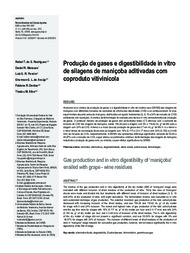Produção de gases e digestibilidade in vitro de silagem de maniçoba aditivadas com coproduto vitivinicola.
Produção de gases e digestibilidade in vitro de silagem de maniçoba aditivadas com coproduto vitivinicola.
Author(s): RODRIGUES, R. T. DE S.; MENEZES, D. R.; PEREIRA, L. G. R.; ARAUJO, G. G. L. de; DANTAS, F. R.; SILVA, T. M.
Summary: RESUMO - Avaliaram-se a cinética da produção de gases e a digestibilidade in vitro da matéria seca (DIVMS) das silagens de maniçoba com diferentes inclusões do coproduto de vitivinícolas desidratado (CVD) e se confeccionaram 32 silos experimentais da parte aérea da maniçoba, distribuídos em quatro tratamentos (0, 8, 16 e 24% de inclusão do CVD) perfazendo oito repetições. A cinética da fermentação foi avaliada pela técnica in vitro semiautomática de produção de gases. O potencial máximo da produção de gases dos carboidratos totais (CT) diminuiu com o aumento da inclusão do CVD nas silagens de maniçoba, sendo 159,39 para a silagem com 0% e 118,62 mL g-1 de MS para a silagem com 24% do CVD. A menor e a maior taxa da produção de gases dos CT em mL g-1 de MS h-1 e o menor e o maior tempo de colonização foram para as silagens com 16% (0,117) e (3 h:17 min) e com 24% (0,150) e (4 h:48 min) de inclusão do CVD, respectivamente. A DIVMS não apresentou diferença significativa variando de 53,50 a 49,07% com a inclusão do CVD, a qual alterou os parâmetros cinéticos da fermentação das silagens de maniçoba reduzindo a produção de gases sem, ao entanto, causar efeitos significativos na DIVMS. ABSTRACT - The kinetics of the gas production and in vitro digestibility of the dry matter (DM) of ?maniçoba? silage were evaluated with different inclusion of dried residues of the production of wine. Thirty two silos of ?maniçoba? shoots were made and divided into four treatments with different levels of inclusion of dried residues (0, 8, 16 and 24%) of the production of wine, with eight replications. The fermentation kinetics was evaluated by in vitro semi-automated technique of gas production. The potential maximum gas production of the total carbohydrates decreased with increasing inclusion of the dried residue, and was 159.39 and 118.62 mL g-1 of dry matter for silage with 0 and 24% inclusion. The lowest and highest rates of gas production of the total carbohydrates and the lag time were for silages with 16% (0.117 mL g-1 of dry matter per hour and 3 h:17 min) and with 24% (0.150 mL g-1 of dry matter per hour and 4 h:48 min) of inclusion of the dried residue. The in vitro digestibility of the dry matter of silage did not present a significant variation, and was 53.50% for silages with 0% and 49.07% for silages with 24% of inclusion. The inclusion of different levels of dried residues of the production of wine in ?maniçoba? silage reduced the cumulative gas production, however, did not reduce significantly the in vitro digestibility of the DM of silage.
Publication year: 2012
Types of publication: Journal article
Unit: Embrapa Dairy Cattle
Observation
Some of Embrapa's publications are published as ePub files. To read them, use or download one of the following free software options to your computer or mobile device. Android: Google Play Books; IOS: iBooks; Windows and Linux: Calibre.
Access other publications
Access the Agricultural Research Database (BDPA) to consult Embrapa's full library collection and records.
Visit Embrapa Bookstore to purchase books and other publications sold by Embrapa.

